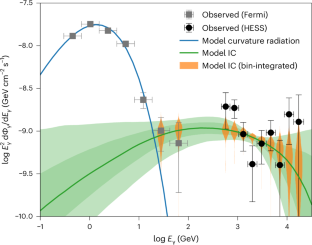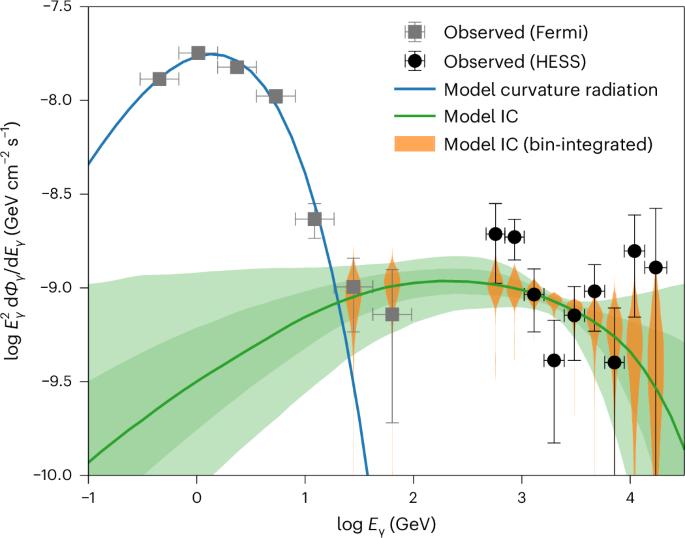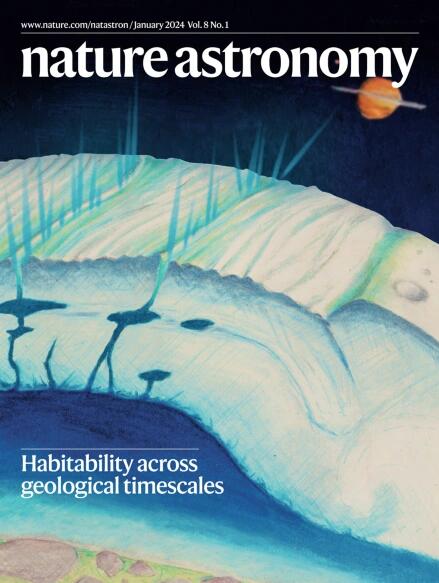Teraelectronvolt gamma-ray emission near globular cluster Terzan 5 as a probe of cosmic ray transport
IF 12.9
1区 物理与天体物理
Q1 ASTRONOMY & ASTROPHYSICS
引用次数: 0
Abstract
The propagation directions of cosmic rays travelling through interstellar space are repeatedly scattered by fluctuating interstellar magnetic fields. The nature of this scattering is a major unsolved problem in astrophysics, one that has resisted solution largely due to a lack of direct observational constraints on the scattering rate. Here we show that very high-energy γ-ray emission from the globular cluster Terzan 5, which has unexpectedly been found to be displaced from the cluster, presents a direct probe of this process. We show that this displacement is naturally explained by cosmic rays accelerated in the bow shock around the cluster, which then propagate a finite distance before scattering processes re-orient enough of them towards Earth to produce a detectable γ-ray signal. The angular distance between the cluster and the signal places tight constraints on the scattering rate, which we show are consistent with a model in which scattering is primarily due to excitation of magnetic waves by the cosmic rays themselves. The analysis method we develop here will make it possible to use sources with similarly displaced non-thermal X-ray and tera-electronvolt γ-ray signals as direct probes of cosmic ray scattering across a range of Galactic environments. How a star cluster manages to produce γ-rays at a location 30 light yr away from itself is a mystery that can be solved by carefully testing theories about how charged particles travel through space.


球状星团泰尔赞 5 附近的太电子伏特伽马射线发射,作为宇宙射线传输的探测器
宇宙射线穿过星际空间时,其传播方向会被波动的星际磁场反复散射。这种散射的性质是天体物理学中一个尚未解决的重大问题,主要由于缺乏对散射率的直接观测约束,这个问题一直没有得到解决。在这里,我们展示了来自球状星团 Terzan 5 的高能 γ 射线辐射,它是对这一过程的直接探测。我们的研究表明,这种位移可以很自然地解释为宇宙射线在星团周围的弓形冲击中被加速,然后传播一段有限的距离,然后散射过程将足够多的宇宙射线重新定向到地球,从而产生可探测到的γ射线信号。星团和信号之间的角距离对散射率有严格的限制,我们的研究表明,这与散射主要是由于宇宙射线本身激发磁波的模型是一致的。我们在这里开发的分析方法将使我们有可能利用具有类似位移的非热 X 射线和太电子伏特 γ 射线信号源来直接探测一系列银河环境中的宇宙射线散射。
本文章由计算机程序翻译,如有差异,请以英文原文为准。
求助全文
约1分钟内获得全文
求助全文
来源期刊

Nature Astronomy
Physics and Astronomy-Astronomy and Astrophysics
CiteScore
19.50
自引率
2.80%
发文量
252
期刊介绍:
Nature Astronomy, the oldest science, has played a significant role in the history of Nature. Throughout the years, pioneering discoveries such as the first quasar, exoplanet, and understanding of spiral nebulae have been reported in the journal. With the introduction of Nature Astronomy, the field now receives expanded coverage, welcoming research in astronomy, astrophysics, and planetary science. The primary objective is to encourage closer collaboration among researchers in these related areas.
Similar to other journals under the Nature brand, Nature Astronomy boasts a devoted team of professional editors, ensuring fairness and rigorous peer-review processes. The journal maintains high standards in copy-editing and production, ensuring timely publication and editorial independence.
In addition to original research, Nature Astronomy publishes a wide range of content, including Comments, Reviews, News and Views, Features, and Correspondence. This diverse collection covers various disciplines within astronomy and includes contributions from a diverse range of voices.
 求助内容:
求助内容: 应助结果提醒方式:
应助结果提醒方式:


